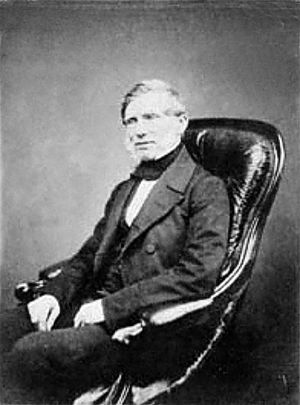John Miers (botanist) facts for kids
John Miers (born August 25, 1789 – died October 17, 1879) was a British botanist and engineer. He is famous for studying the plants (flora) of Chile and Argentina. He was also a member of important groups like the Royal Society.
Contents
Early Life and Interests
John Miers was born in London. His father was a jeweller from Yorkshire. From a young age, John was very interested in mineralogy, which is the study of minerals. He also loved chemistry.
His first published work was about nitrogen. It appeared in a science magazine called Annals of Philosophy in 1814.
Journey to South America
In 1818, John Miers got married. Soon after, he traveled to South America. He planned to work on a project to find and use mineral resources in Chile, especially copper.
However, after arriving in Buenos Aires, his wife became very ill. Because of this, he decided not to continue his journey to Chile right away. Instead, he started to study the local plants. At that time, not many people had researched the plants in that area.
Work in Chile
In May 1819, Miers finally arrived in Santiago, Chile. He had secretly arranged to transport coin presses. He settled in a place called Concón, which is near Valparaíso.
He started working with Lord Cochrane. Lord Cochrane was the head of the Chilean Navy. Together, they built a flour mill. They also planned to start a large farm at Quintero. Their goal was to become the main suppliers of food like salted beef and biscuits to the Navy.
Return to England and Later Work
In 1825, John Miers returned to England. The next year, he published a book called Travels in Chile and La Plata. This was the first of many books he wrote about the plants of South America.
Later, he went back to Argentina. He worked on contracts for the Argentinian mint, which makes coins. But political problems stopped this work in 1831. He then moved to Rio de Janeiro in Brazil to do similar work for the Brazilian government. He returned to England in 1838.
Miers was a Fellow of the Royal Society. This means he was a respected member of an important scientific group. He helped edit the scientific papers of other people. He also edited his own writings.
Important Contributions to Botany
John Miers's most important book was Contributions to the Botany of South America, published in 1870. Other well-known books he wrote include On the Apocynaceae of South America (1878) and Illustrations of South American Plants.
Many types of plants (called taxa) have been named in his honor. For example:
- In 1826, a botanist named John Lindley named a plant genus Miersia after him. All five known species of Miersia are found in Chile and Bolivia.
- In 1903, another botanist, Ignatz Urban, named a genus of flowering plants from South America Miersiella. This was also done to honor John Miers.
See also
 In Spanish: John Miers para niños
In Spanish: John Miers para niños


